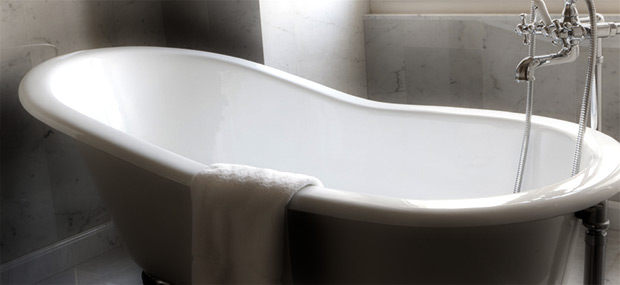For many people, bathtubs play a significant role in their lives. From spending quiet evenings soaking in a tub of bubbles with a good book to watching children playing with toys during their daily wash down, your bath is an important part of your home. Over time the bath surface starts to deteriorate, aided by this leaky faucet, the backup from that clogged drain, and even if you have regular plumbing service inspections, you may reach the point where you need to consider resurfacing the tub.
Type of Finish
The kind of bathtub you have will determine whether you can resurface the tub or not. If it’s made from a fiberglass shell, chances are it will be easier and less costly to simply replace the tub with a new one. If it’s an old porcelain tub, however, refinishing is a good idea. Your plumbing service will be able to give you a good idea of the best option for your type of bathtub.
Inspect First
Before you can start working on the bathtub, you need to make sure it is completely clean. This is also a good time to check all your visible plumbing connections and repair or replace any leaky faucets, broken pipes or clogged drains. Schedule an appointment with your plumbing service contractor to do a thorough inspection and give you a quote to perform any repairs you need.
Preparing the Tub
- First, scrub the surface of the bathtub thoroughly using your regular cleaning solution. Rinse carefully to remove all traces of cleaner and dry with an old towel.
- Next, sand down the entire surface of the tub using 120-grit sandpaper, paying particular attention to the edges, stains caused by leaky faucets and rusted or discolored areas. This not only roughens the surface for the new finish to adhere more easily but also gets rid of the last traces of cleaning solution.
- Vacuum the dust from the sanding out of the bath, to prevent it causing a clogged drain and resulting in the need to call plumbing services.
- Then rinse the bath with warm water and leave it for a couple of hours to dry completely.
- Fill any hollows, dents, cracks or chips with epoxy filler, which you can smooth out with a damp sponge for an even look.
- Finally, put masking tape on the first row of tiles surrounding the tub to avoid painting them by accident.
Adding the Surface
Mix epoxy paint or the bath resurfacing product you’ve chosen and prepare to apply it. Paint it onto the sides of the tub, the corners and around the faucets using a paintbrush. Apply it to the wider sections of the bath’s sides and floor, working in one direction only and using light strokes to apply a thin coat. Allow it to dry for the recommended period of time, followed by a second and perhaps a third thin coat. Once the final coat has dried, add a glaze or UV finish if you want a high shine, hard surface.
A resurfaced tub can transform your bathroom and bring you pleasure for many years to come. Don’t let a stained tub, leaky faucet or clogged drain spoil bath time for your family. If you aren’t particularly handy, speak with your plumbing service professionals to discuss the options for resurfacing your bath and resolving your other plumbing problems. Contact your local plumber today for a free consultation and an estimate for the help you need.

